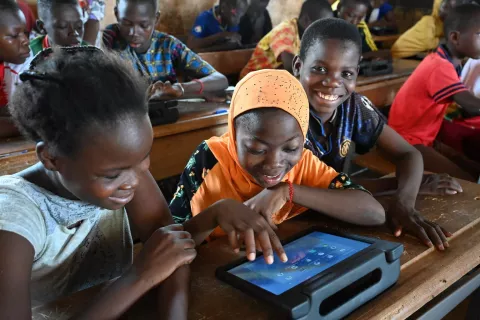Frugal innovation: What we have learned
Six insights for multilateral institutions in the hyper-local, frugal innovation ecosystem

Innovation often brings to mind technology solutions, shiny objects and life improvements that would have generally seemed far-fetched a decade ago or so, including personalized medicine, self-driving cars or distance learning.
Innovation, however, presents itself in all sorts of shapes and sizes, and comes from the unlikeliest of places. Solutions that grab few headlines may even be more life-impacting. Proof of this is to be found among the so-called frugal innovations, a term that refers to products or services born out of necessity and in contexts that happen to be limited in available resources.
Working with people on the ground across geographies and on several programme areas, UNICEF has first-hand experience of the impact that frugal innovations have in local development, learning from and refining its engagement with local communities.
Frugal innovation’s strength lies in its local, context-specific and community-led nature. This means that that multilateral organizations, like UNICEF, can add value, but in very different ways compared to regular innovation programmes.
Here are the six most significant lessons we’ve learned that hold relevance for other similar organizations looking to contribute to helping frugal innovation ecosystems and solutions to flourish.

1. A shared definition of what frugal innovation means for your organization may seem too obvious a point, but in our experience it remains worth noting. Our definition is that “frugal innovations are simple products or services that are dramatically lower in cost, outperform alternatives and can be scaled up through adoption by people who do not need special expertise or equipment.” This helps us be clear that for UNICEF, frugal innovation is not only defined by cost effectiveness, but equally that the solution should be able to be adopted and adapted by anyone in a do-it-yourself approach.
2. Frugal innovation demands authentic, community-led and -centred engagement. By its very nature, frugal innovations are designed by community members themselves who identify the problems they live with, ideate, tinker and build prototypes and proofs of concepts, and those perceived as useful spread through word of mouth and personal testimony. Organizations who want to engage and contribute must therefore do so in a manner that honors this empowered approach, as a passenger and not seeking to get into the driver’s seat.
3. What does a solver look like? She or he is just as likely to be a young girl as a community elder. No one has exclusivity on innovating and organizations like ours can play a powerful role in making the space and opportunities available to nurture diversity in gender, age, people with disabilities and other marginal and discriminated profiles. UNICEF’s UPSHIFT programme as well as the Generation Unlimited Youth Challenge are designed to support young and diverse solvers be more effective in their innovation through cultivating context-relevant human-centred design or design thinking techniques.
4. Access to expertise, evidence and validation are among the valuable contributions multilaterals can contribute to the frugal innovation ecosystems. In many instances, communities have already developed products or services in line with their needs, such as clay water filters to improve water quality or a myriad of tweaks to improve insulation of and air quality in traditional dwellings. The lack of expertise and evidence to validate whether these strategies are effective limits community confidence in the ideas and their spread – regardless of whether they are effective or not. Cooperating with external partners can help to improve solutions, build validation on their effectiveness, and support their adoption.
5. Knowhow is the silver bullet. One of the most significant drags on the adoption of frugal innovations is that being hyper-local limits the radius of their spread – whether restricted physically or socially. Communication is therefore a critical success factor in amplifying the reach and impact of frugal innovations, and locally credible influencers remain highly effective. Several tools and tactics can be borrowed from fields as diverse as social and cognitive science, behavioral economics, social and behavioural change, and communications for development.
6. Connecting communities. Organizations can make useful contributions by using their larger geographical networks to connect communities and solvers to each other and to relevant ideas and efforts, as they rarely have line of sight to this broader network. Many of the frugal innovations that UNICEF has contributed to in partnership with local stakeholders can be found across geographies and programme areas for this reason.
UNICEF has distilled these insights through engaging in frugal innovation ecosystems and solution building as a partner to community-led solvers around the world. This experience has helped us hone our value add in hyper-local, frugal innovation ecosystems, which is significantly different to other types of innovation initiatives. Nonetheless, this is an area where multilateral organizations such as UNDP, UNHCR, and UNICEF have been engaging with impact.



